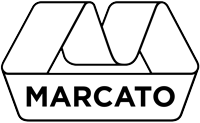












Manual pasta makers are the most practical solution for those who want to make homemade pasta traditionally, without the need for electric or automated tools. These devices are used both in domestic settings and in more structured environments, where the quality of fresh pasta is a priority. Using a manual pasta machine allows for precise and consistent handling of different types of dough, ensuring professional results even with hobbyist use.
The operation of these machines is simple: the dough is fed between the rollers and worked by turning a crank. Thanks to mechanical adjustment systems, it is possible to obtain sheets of various widths and thicknesses, thus adapting the preparation to different types of pasta. The main feature of manual homemade pasta machines is their durability, resulting from the use of solid materials such as stainless steel, bronze, or food-grade ABS. This construction ensures wear resistance, ease of cleaning, and safe contact with food.
Manual pasta machines also stand out for the presence of interchangeable pasta discs, which allow the creation of many different formats such as tagliatelle, pappardelle, spaghetti, penne, fusilli, and lasagne. The wide availability of discs allows experimentation with different formats and recipes, making these tools ideal for both beginners in homemade pasta making and those looking for a performant product for professional use. The ability to adjust the sheet width, combined with the ease of use, makes the manual pasta maker an indispensable tool for every traditional cooking enthusiast.
On AgriEuro, it is possible to filter products based on their technical features, in order to select the one that best meets your usage needs. Each manual pasta machine is designed to offer high quality and long-lasting durability, with features that vary depending on the model and the user’s requirements. Below are the main technical features that distinguish these machines.
A manual homemade pasta maker is an indispensable tool for those who want to make artisanal pasta at home, with the ability to customize the recipe and pasta format. These devices are ideal for those seeking a traditional approach to pasta making, requiring minimal mechanical intervention, but still providing precise and professional results. Using a manual pasta machine allows for the creation of perfect sheets and different formats without needing electronic or industrial tools.
Manual machines are designed to handle dough of various consistencies and allow for the creation of uniform sheets of pasta with the right texture for each format. The interchangeable discs make it easy to switch between formats such as tagliatelle, spaghetti, pappardelle, or fusilli, adapting to all preferred recipes. These machines are perfect for preparing homemade fresh pasta for dishes like lasagne, ravioli, or any other preparation requiring fresh pasta.
Some practical usage examples include:
Manual pasta makers are particularly ideal for hobbyist use, but some models are robust enough to meet the needs of those who use them more frequently or for small-scale professional production. Thanks to their solid construction and the ability to adjust the sheets, these machines are also excellent for more experienced cooks who want full control over pasta preparation.
Manual homemade pasta machines offer numerous advantages, both in terms of performance and practicality. Their durability, combined with the ability to adjust sheet thickness and choose from various formats, makes them highly appreciated in kitchens. Below are the main strengths:
Buying a crank-powered pasta machine on AgriEuro means choosing quality, reliability, and convenience. Our e-commerce specializes in the sale of gardening, agriculture, and kitchen equipment, offering high-quality products like pasta makers at competitive prices. The benefits of buying on AgriEuro include:
Buying on AgriEuro means relying on an experienced and trustworthy partner for your culinary needs. Don't miss the opportunity to buy a high-quality manual pasta maker on AgriEuro!
Discover the AgriEuro 2025 Catalogue for ( Pasta Makers Manual )
Constantly expanded and updated.
Last updated 22/12/2025